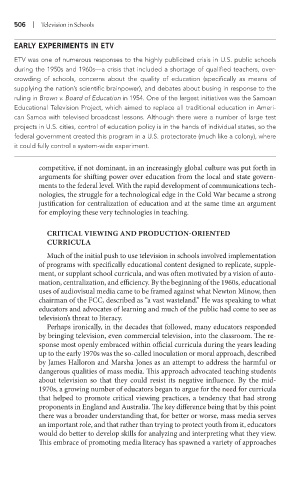Page 527 - Battleground The Media Volume 1 and 2
P. 527
0 | Telev s on n Schools
early exPeriMents in etV
ETV was one of numerous responses to the highly publicized crisis in U.S. public schools
during the 1950s and 1960s—a crisis that included a shortage of qualified teachers, over-
crowding of schools, concerns about the quality of education (specifically as means of
supplying the nation’s scientific brainpower), and debates about busing in response to the
ruling in Brown v. Board of Education in 1954. One of the largest initiatives was the Samoan
Educational Television Project, which aimed to replace all traditional education in Ameri-
can Samoa with televised broadcast lessons. Although there were a number of large test
projects in U.S. cities, control of education policy is in the hands of individual states, so the
federal government created this program in a U.S. protectorate (much like a colony), where
it could fully control a system-wide experiment.
competitive, if not dominant, in an increasingly global culture was put forth in
arguments for shifting power over education from the local and state govern-
ments to the federal level. With the rapid development of communications tech-
nologies, the struggle for a technological edge in the Cold War became a strong
justification for centralization of education and at the same time an argument
for employing these very technologies in teaching.
CriTiCaL viEwing anD ProDuCTion-oriEnTED
CurriCuLa
Much of the initial push to use television in schools involved implementation
of programs with specifically educational content designed to replicate, supple-
ment, or supplant school curricula, and was often motivated by a vision of auto-
mation, centralization, and efficiency. By the beginning of the 1960s, educational
uses of audiovisual media came to be framed against what Newton Minow, then
chairman of the FCC, described as “a vast wasteland.” He was speaking to what
educators and advocates of learning and much of the public had come to see as
television’s threat to literacy.
Perhaps ironically, in the decades that followed, many educators responded
by bringing television, even commercial television, into the classroom. The re-
sponse most openly embraced within official curricula during the years leading
up to the early 1970s was the so-called inoculation or moral approach, described
by James Halloron and Marsha Jones as an attempt to address the harmful or
dangerous qualities of mass media. This approach advocated teaching students
about television so that they could resist its negative influence. By the mid-
1970s, a growing number of educators began to argue for the need for curricula
that helped to promote critical viewing practices, a tendency that had strong
proponents in England and Australia. The key difference being that by this point
there was a broader understanding that, for better or worse, mass media serves
an important role, and that rather than trying to protect youth from it, educators
would do better to develop skills for analyzing and interpreting what they view.
This embrace of promoting media literacy has spawned a variety of approaches

